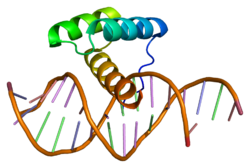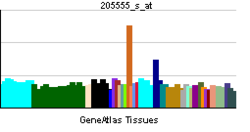- Msh homeobox 2
-
Homeobox protein MSX-2 is a protein that in humans is encoded by the MSX2 gene.[1][2][3]
This gene encodes a member of the muscle segment homeobox gene family. The encoded protein is a transcriptional repressor whose normal activity may establish a balance between survival and apoptosis of neural crest-derived cells required for proper craniofacial morphogenesis. The encoded protein may also have a role in promoting cell growth under certain conditions and may be an important target for the RAS signaling pathways. Mutations in this gene are associated with parietal foramina 1 and craniosynostosis type 2.[3]
Contents
Interactions
Msh homeobox 2 has been shown to interact with DLX5,[4] DLX2[4] and MSX1.[4]
References
- ^ Takahashi C, Akiyama N, Matsuzaki T, Takai S, Kitayama H, Noda M (Aug 1996). "Characterization of a human MSX-2 cDNA and its fragment isolated as a transformation suppressor gene against v-Ki-ras oncogene". Oncogene 12 (10): 2137–46. PMID 8668339.
- ^ Kostrzewa M, Grady DL, Moyzis RK, Floter L, Muller U (Sep 1996). "Integration of four genes, a pseudogene, thirty-one STSs, and a highly polymorphic STRP into the 7-10 Mb YAC contig of 5q34-q35". Hum Genet 97 (3): 399–403. doi:10.1007/BF02185781. PMID 8786091.
- ^ a b "Entrez Gene: MSX2 msh homeobox 2". http://www.ncbi.nlm.nih.gov/sites/entrez?Db=gene&Cmd=ShowDetailView&TermToSearch=4488.
- ^ a b c Zhang, H; Hu G, Wang H, Sciavolino P, Iler N, Shen M M, Abate-Shen C (May. 1997). "Heterodimerization of Msx and Dlx homeoproteins results in functional antagonism". Mol. Cell. Biol. (UNITED STATES) 17 (5): 2920–32. ISSN 0270-7306. PMC 232144. PMID 9111364. http://www.pubmedcentral.nih.gov/articlerender.fcgi?tool=pmcentrez&artid=232144.
Further reading
- Suzuki M, Tanaka M, Iwase T, et al. (1993). "Over-expression of HOX-8, the human homologue of the mouse Hox-8 homeobox gene, in human tumors.". Biochem. Biophys. Res. Commun. 194 (1): 187–93. doi:10.1006/bbrc.1993.1802. PMID 7687426.
- Semenza GL, Wang GL, Kundu R (1995). "DNA binding and transcriptional properties of wild-type and mutant forms of the homeodomain protein Msx2.". Biochem. Biophys. Res. Commun. 209 (1): 257–62. doi:10.1006/bbrc.1995.1497. PMID 7726844.
- Iimura T (1995). "[Molecular cloning and expression of homeobox-containing genes during hard tissue development]". Kokubyo Gakkai Zasshi 61 (4): 590–604. PMID 7897272.
- Hodgkinson JE, Davidson CL, Beresford J, Sharpe PT (1993). "Expression of a human homeobox-containing gene is regulated by 1,25(OH)2D3 in bone cells.". Biochim. Biophys. Acta 1174 (1): 11–6. PMID 8101453.
- Jabs EW, Müller U, Li X, et al. (1993). "A mutation in the homeodomain of the human MSX2 gene in a family affected with autosomal dominant craniosynostosis.". Cell 75 (3): 443–50. doi:10.1016/0092-8674(93)90379-5. PMID 8106171.
- Ma L, Golden S, Wu L, Maxson R (1997). "The molecular basis of Boston-type craniosynostosis: the Pro148-->His mutation in the N-terminal arm of the MSX2 homeodomain stabilizes DNA binding without altering nucleotide sequence preferences.". Hum. Mol. Genet. 5 (12): 1915–20. doi:10.1093/hmg/5.12.1915. PMID 8968743.
- Quinn LM, Johnson BV, Nicholl J, et al. (1997). "Isolation and identification of homeobox genes from the human placenta including a novel member of the Distal-less family, DLX4.". Gene 187 (1): 55–61. doi:10.1016/S0378-1119(96)00706-8. PMID 9073066.
- Zhang H, Hu G, Wang H, et al. (1997). "Heterodimerization of Msx and Dlx homeoproteins results in functional antagonism.". Mol. Cell. Biol. 17 (5): 2920–32. PMC 232144. PMID 9111364. http://www.pubmedcentral.nih.gov/articlerender.fcgi?tool=pmcentrez&artid=232144.
- Wu L, Wu H, Ma L, et al. (1997). "Miz1, a novel zinc finger transcription factor that interacts with Msx2 and enhances its affinity for DNA.". Mech. Dev. 65 (1-2): 3–17. doi:10.1016/S0925-4773(97)00032-4. PMID 9256341.
- Newberry EP, Latifi T, Battaile JT, Towler DA (1997). "Structure-function analysis of Msx2-mediated transcriptional suppression.". Biochemistry 36 (34): 10451–62. doi:10.1021/bi971008x. PMID 9265625.
- Stelnicki EJ, Kömüves LG, Holmes D, et al. (1997). "The human homeobox genes MSX-1, MSX-2, and MOX-1 are differentially expressed in the dermis and epidermis in fetal and adult skin.". Differentiation 62 (1): 33–41. doi:10.1046/j.1432-0436.1997.6210033.x. PMID 9373945.
- Iimura T, Takeda K, Goseki M, et al. (1998). "Characterization of two length cDNA for human MSX-2 from dental pulp-derived cells.". DNA Seq. 8 (1-2): 87–92. PMID 9522127.
- Newberry EP, Latifi T, Towler DA (1999). "The RRM domain of MINT, a novel Msx2 binding protein, recognizes and regulates the rat osteocalcin promoter.". Biochemistry 38 (33): 10678–90. doi:10.1021/bi990967j. PMID 10451362.
- Wilkie AO, Tang Z, Elanko N, et al. (2000). "Functional haploinsufficiency of the human homeobox gene MSX2 causes defects in skull ossification.". Nat. Genet. 24 (4): 387–90. doi:10.1038/74224. PMID 10742103.
- Wuyts W, Reardon W, Preis S, et al. (2000). "Identification of mutations in the MSX2 homeobox gene in families affected with foramina parietalia permagna.". Hum. Mol. Genet. 9 (8): 1251–5. doi:10.1093/hmg/9.8.1251. PMID 10767351.
- Quinn LM, Latham SE, Kalionis B (2000). "The homeobox genes MSX2 and MOX2 are candidates for regulating epithelial-mesenchymal cell interactions in the human placenta.". Placenta. 21 Suppl A: S50–4. doi:10.1053/plac.1999.0514. PMID 10831122.
- Masuda Y, Sasaki A, Shibuya H, et al. (2001). "Dlxin-1, a novel protein that binds Dlx5 and regulates its transcriptional function.". J. Biol. Chem. 276 (7): 5331–8. doi:10.1074/jbc.M008590200. PMID 11084035.
- Shirakabe K, Terasawa K, Miyama K, et al. (2002). "Regulation of the activity of the transcription factor Runx2 by two homeobox proteins, Msx2 and Dlx5.". Genes Cells 6 (10): 851–6. doi:10.1046/j.1365-2443.2001.00466.x. PMID 11683913.
PDB gallery External links
- GeneReviews/NCBI/UW/NIH entry on Enlarged Parietal Foramina/Cranium Bifidum
- MeSH MSX2+protein,+human
This article incorporates text from the United States National Library of Medicine, which is in the public domain.
Transcription factors and intracellular receptors (1) Basic domains (1.1) Basic leucine zipper (bZIP)Activating transcription factor (AATF, 1, 2, 3, 4, 5, 6, 7) · AP-1 (c-Fos, FOSB, FOSL1, FOSL2, JDP2, c-Jun, JUNB, JUND) · BACH (1, 2) · BATF · BLZF1 · C/EBP (α, β, γ, δ, ε, ζ) · CREB (1, 3, L1) · CREM · DBP · DDIT3 · GABPA · HLF · MAF (B, F, G, K) · NFE (2, L1, L2, L3) · NFIL3 · NRL · NRF (1, 2, 3) · XBP1(1.2) Basic helix-loop-helix (bHLH)ATOH1 · AhR · AHRR · ARNT · ASCL1 · BHLHB2 · BMAL (ARNTL, ARNTL2) · CLOCK · EPAS1 · FIGLA · HAND (1, 2) · HES (5, 6) · HEY (1, 2, L) · HES1 · HIF (1A, 3A) · ID (1, 2, 3, 4) · LYL1 · MESP2 · MXD4 · MYCL1 · MYCN · Myogenic regulatory factors (MyoD, Myogenin, MYF5, MYF6) · Neurogenins (1, 2, 3) · NeuroD (1, 2) · NPAS (1, 2, 3) · OLIG (1, 2) · Pho4 · Scleraxis · SIM (1, 2) · TAL (1, 2) · Twist · USF1(1.3) bHLH-ZIP(1.4) NF-1(1.5) RF-X(1.6) Basic helix-span-helix (bHSH)(2) Zinc finger DNA-binding domains (2.1) Nuclear receptor (Cys4)subfamily 1 (Thyroid hormone (α, β), CAR, FXR, LXR (α, β), PPAR (α, β/δ, γ), PXR, RAR (α, β, γ), ROR (α, β, γ), Rev-ErbA (α, β), VDR)
subfamily 2 (COUP-TF (I, II), Ear-2, HNF4 (α, γ), PNR, RXR (α, β, γ), Testicular receptor (2, 4), TLX)
subfamily 3 (Steroid hormone (Androgen, Estrogen (α, β), Glucocorticoid, Mineralocorticoid, Progesterone), Estrogen related (α, β, γ))
subfamily 4 NUR (NGFIB, NOR1, NURR1) · subfamily 5 (LRH-1, SF1) · subfamily 6 (GCNF) · subfamily 0 (DAX1, SHP)(2.2) Other Cys4(2.3) Cys2His2General transcription factors (TFIIA, TFIIB, TFIID, TFIIE (1, 2), TFIIF (1, 2), TFIIH (1, 2, 4, 2I, 3A, 3C1, 3C2))
ATBF1 · BCL (6, 11A, 11B) · CTCF · E4F1 · EGR (1, 2, 3, 4) · ERV3 · GFI1 · GLI-Krüppel family (1, 2, 3, REST, S2, YY1) · HIC (1, 2) · HIVEP (1, 2, 3) · IKZF (1, 2, 3) · ILF (2, 3) · KLF (2, 3, 4, 5, 6, 7, 8, 9, 10, 11, 12, 13, 14, 15, 17) · MTF1 · MYT1 · OSR1 · PRDM9 · SALL (1, 2, 3, 4) · SP (1, 2, 4, 7, 8) · TSHZ3 · WT1 · Zbtb7 (7A, 7B) · ZBTB (16, 17, 20, 32, 33, 40) · zinc finger (3, 7, 9, 10, 19, 22, 24, 33B, 34, 35, 41, 43, 44, 51, 74, 143, 146, 148, 165, 202, 217, 219, 238, 239, 259, 267, 268, 281, 295, 300, 318, 330, 346, 350, 365, 366, 384, 423, 451, 452, 471, 593, 638, 644, 649, 655)(2.4) Cys6(2.5) Alternating composition(3) Helix-turn-helix domains (3.1) HomeodomainARX · CDX (1, 2) · CRX · CUTL1 · DBX (1, 2) · DLX (3, 4, 5) · EMX2 · EN (1, 2) · FHL (1, 2, 3) · HESX1 · HHEX · HLX · Homeobox (A1, A2, A3, A4, A5, A7, A9, A10, A11, A13, B1, B2, B3, B4, B5, B6, B7, B8, B9, B13, C4, C5, C6, C8, C9, C10, C11, C13, D1, D3, D4, D8, D9, D10, D11, D12, D13) · HOPX · IRX (1, 2, 3, 4, 5, 6, MKX) · LMX (1A, 1B) · MEIS (1, 2) · MEOX2 · MNX1 · MSX (1, 2) · NANOG · NKX (2-1, 2-2, 2-3, 2-5, 3-1, 3-2, 6-1, 6-2) · NOBOX · PBX (1, 2, 3) · PHF (1, 3, 6, 8, 10, 16, 17, 20, 21A) · PHOX (2A, 2B) · PITX (1, 2, 3) · POU domain (PIT-1, BRN-3: A, B, C, Octamer transcription factor: 1, 2, 3/4, 6, 7, 11) · OTX (1, 2) · PDX1 · SATB2 · SHOX2 · VAX1 · ZEB (1, 2)(3.2) Paired box(3.3) Fork head / winged helix(3.4) Heat Shock Factors(3.5) Tryptophan clusters(3.6) TEA domain(4) β-Scaffold factors with minor groove contacts (4.1) Rel homology region(4.2) STAT(4.3) p53(4.4) MADS box(4.6) TATA binding proteins(4.7) High-mobility group(4.10) Cold-shock domainCSDA, YBX1(4.11) Runt(0) Other transcription factors (0.2) HMGI(Y)(0.3) Pocket domain(0.6) Miscellaneoussee also transcription factor/coregulator deficiencies
B bsyn: dna (repl, cycl, reco, repr) · tscr (fact, tcrg, nucl, rnat, rept, ptts) · tltn (risu, pttl, nexn) · dnab, rnab/runp · stru (domn, 1°, 2°, 3°, 4°)Categories:- Human proteins
- Transcription factors
- Chromosome 5 gene stubs
Wikimedia Foundation. 2010.




